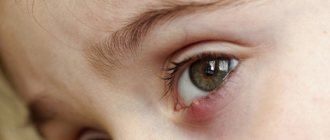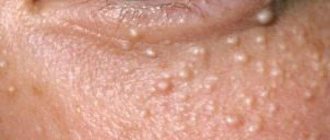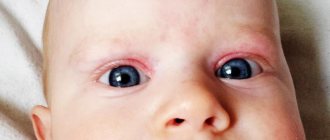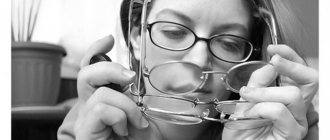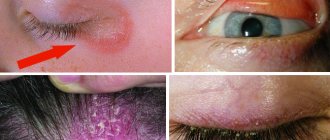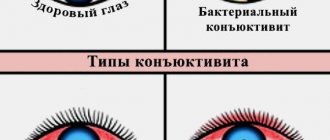Blepharitis is an eye disease that manifests itself as inflammation of the eyelids. Often, children, like adults, can get this disease, since the baby’s immunity is still too weak to fight this kind of disease. Very often, blepharitis in children occurs in a chronic form, and treatment of this type requires special attention and urgent need to contact specialists. If this is not done in a timely manner, it can lead to various types of complications.
How to deal with such a disease and what blepharitis in children is, we will tell you in this article, as well as what you need to do to avoid this disease.
Etiology of the disease
Blepharitis in children.
Source: o-krohe.ru In the vast majority of cases, pathology occurs due to excess sebum, which accumulates on the edges of the eyelids. This phenomenon provokes bacteria to actively reproduce, resulting in inflammation.
Blepharitis may be accompanied by seborrheic dermatitis, in which case dry skin patches on the face or scalp begin to peel. An allergic reaction may occur, which is accompanied by redness of the skin.
Blepharitis in children occurs when basic hygiene standards are not observed, if the child has been exposed to the wind for a long time, if vision is impaired, or if there are parasites or infections in the body.
Numerous microorganisms can cause blepharitis in a child - molluscum contagiosum, herpes virus, fungi, mites, staphylococcus and others. Sometimes the cause may be chronic anemia, vitamin deficiency, diseases of the oral cavity and nasopharynx, and problems with the gastrointestinal tract.
Characteristic symptoms
Blepharitis in children has various symptoms, which directly depend on the form and extent of the lesion. Similar symptoms are also inherent in other ophthalmological diseases; it is important not to confuse them. If negative symptoms occur in a child, you should consult a doctor. Symptoms and treatment depend on the form and extent of the lesion.
Blepharitis is manifested by the following symptoms:
- puffiness, swelling and redness of the eyelids;
- itching and burning;
- increased lacrimation;
- photophobia;
- the formation of scales on the eyelashes that are difficult to remove;
- purulent blisters;
- painful sensations.
In the absence of proper drug treatment, a number of complications arise:
- ulcers on the surface of the eyelid;
- thickening of the eyelids;
- damage to the eyelash bulbs, which leads to their loss;
- narrowness of the eye slit.
The symptoms are pronounced, so they are noticeable.
Blepharitis in children. Signs of the disease
Signs Source: o-glazah.ru
With blepharitis, the baby suffers greatly from itching, sometimes it can be simply unbearable. The eyelid turns red, a burning sensation appears, there is a feeling that something has got into the eye, and the child suffers from severe lacrimation. Upon examination, you may find that the edges of the eyelids are thickened.
- With scaly blepharitis, there are small scales near the eyelashes, and the skin underneath is red and thin.
- In the ulcerative form of the disease, purulent crusts are characteristic; if you try to remove them yourself, they are removed along with the eyelashes, and in place of the crust a small ulcer appears, in most cases it bleeds.
- With demodectic blepharitis, the symptoms are very similar to the symptoms of scaly blepharitis. The eyelash bulbs enlarge, transparent muffs appear at their roots, pigmentation may change and a large number of papillomas may appear.
- With meibomian blepharitis, the symptoms are similar to other forms of the disease, a characteristic feature is small blisters on the upper part of the eyelid, they cause inflammation of the meibomian glands, these blisters break over time and small scars form in their place.
If blepharitis is not treated, it becomes chronic and can severely impair the child’s vision. At the same time, the child feels unwell, his activity decreases sharply.
Seborrheic blepharitis - prevention
To prevent relapses of blepharitis, children must carefully follow a set of preventive measures recommended by their doctor. The main task of the parents of a child who has had blepharitis is to prevent the disease from reoccurring, and for this it is necessary to completely cure the disease. Even if the main symptoms have disappeared, it is worth continuing treatment: taking prescribed medications, doing eyelid massages, going to physiotherapy, protecting your eyes from external influences.
Relapse of blepharitis can also be provoked by new diseases, intoxication of the body, overheating and hypothermia, and unfavorable environmental conditions in the area, city, or region.
What is required to strengthen a child’s immune system?
- enriching the child’s diet with vegetables, fruits, leafy greens, as well as legumes and seafood, pickles and smoked foods should be excluded;
- daily physical activity: running, gymnastics, outdoor fitness;
- taking multivitamin preparations that increase immunity;
- control of visual stress, adherence to sleep and rest schedules;
- Monitor the microclimate in your home and clean it regularly.
You can overcome blepharitis if you make your child healthier and teach him the rules of personal hygiene. At the first feeling of discomfort in the eyes, with redness and swelling of the eyelids, you must seek qualified help.
Causes
Causes of occurrence Source: zreniemed.ru
Most often, the causative agent of blepharitis in children is Staphylococcus aureus, which is activated in the body under certain conditions. However, the nature of the disease can also be parasitic or caused by various other factors.
The causes of childhood blepharitis can be:
- past infectious diseases;
- severe fatigue (both physical and mental);
- hypothermia;
- demodex mite, which gets into the eyelash bulbs when the baby comes into contact with birds, down and feather pillows, as well as in case of chronic gastrointestinal problems, diabetes, various types of allergies, focal points of infection;
- weakened immune system;
- problems with the gastrointestinal tract (colitis, gastritis, cholecystitis);
- constant visual tension;
- diabetes;
- worms;
- dirt getting under the eyelids;
- sensitivity to various irritants (pollen, cosmetics, dust);
- metabolic disorders in the body;
- bleeding from a diseased tooth, tonsils in chronic tonsillitis;
- refusal to wear glasses if you are farsighted, as the eye muscles suffer from tension and fatigue;
- avitaminosis;
- rubbing the eyes with dirty hands;
- anemia;
- external atmospheric phenomena: exposure to wind, smoke, dust.
If parents know exactly what causes can cause such an unpleasant disease in a child as blepharitis, they can somehow protect the eyes from infection. First, teach him to follow basic hygiene rules. Secondly, introduce him to a healthy lifestyle from an early age.
Thirdly, treat any internal diseases in a timely manner. If it was not possible to protect the baby, you need to see the first signs of blepharitis in a timely manner. This will allow treatment to begin as early as possible.
Treatment prognosis and possible complications
If you follow all the ophthalmologist's recommendations, the prognosis is positive. With insufficient treatment of blepharitis or lack of treatment, there is a high risk of complications and consequences:
- loss and abnormal growth of eyelashes;
- impaired lacrimation: dryness, increased lacrimation;
- discomfort when wearing contact lenses;
- risk of visual acuity impairment;
- transition of the disease to the chronic stage.
Blepharitis is easier to prevent than to treat. To prevent pathology, it is necessary to teach the child to observe the rules of personal hygiene: do not rub his eyes, do not allow dirt to get into them, wash his hands after visiting the street. The baby should receive a balanced diet and take the necessary vitamins and minerals. To strengthen the immune system, you need to practice hardening, walking in the fresh air, and playing sports. At the first signs of inflammation in children, you should immediately contact the clinic.
Symptoms
The complexity of this disease is that the symptoms of blepharitis in a child are easily confused with signs of other eye diseases. The same barley, for example. Therefore, if abnormal, unhealthy phenomena occur in the baby’s eyes over a certain period of time, parents should seek help from a doctor as soon as possible. These symptoms may include:
- swelling, swelling of the eyelids;
- redness of the conjunctiva of the eyes;
- sticking and loss of eyelashes;
- itching;
- burning;
- hyperemia;
- irritation under the lower eyelid;
- narrowing of the palpebral fissure;
- thickening of the eyelids;
- crusts along the edges of the eyelashes, which then turn into bleeding ulcers;
- if there is inflammation of the meibomian glands, when pressure is applied to the eyelids, a whitish mass of a yellowish tint flows out from under them;
- feeling of discomfort in the eye area;
- peeling of the skin on the head, around the eyebrows and eyes;
- telangiectasia is a visible dilatation of small blood vessels of the skin in the form of a mesh or stars.
Important:
If there are several such manifestations, it is recommended to show the child to a doctor as soon as possible and not self-medicate.
Symptoms of blepharitis are a signal that specialist intervention is required. Only he will be able to conduct a competent diagnosis and prescribe therapy in accordance with the type of disease.
What is allergic blepharitis
The medical term blepharitis refers to an inflammatory reaction affecting the lower and upper eyelids. It is characterized by erythematous-exudative changes; the irritant is most often allergens acting at the local level.
What does allergic blepharitis look like?
It is possible that symptoms of pathology may appear in response to the introduction of allergens into the body along with food and medicines.
The acute form of the disease passes quickly with proper treatment. Recurrent blepharitis occurs with repeated contact with allergens and is considered chronic.
Inflammation of the eyelids has a negative impact not only on well-being and quality of life, but can also cause deterioration of vision. In the acute stage of the disease, if hygiene measures are not observed, infection with pathogenic microorganisms is possible, which only aggravates the severity of blepharitis and complicates recovery.
In ICD 10, allergic blepharitis is designated by code H01.1 (Non-infectious dermatoses of the eyelid).
Diagnostics
Diagnostics Source: o-krohe.ru
In order to find out what kind of infection provoked the occurrence of blepharitis, the doctor makes a scraping from the conjunctiva of the eyelashes and eyes. Laboratory testing will reveal the cause of the disease.
If the pathology is the result of an allergy, then an additional test is prescribed to identify the provoking factor.
To clarify the etiology of blepharitis, microscopy of a preparation prepared from 4-6 epilated eyelashes should be performed. Usually, the presence of one or two mites is detected on 16 eyelashes (4 eyelashes are taken from each eyelid).
Is treatment with folk remedies effective?
Blepharitis in a child can be treated with herbal medicine - this will help with irritation and relieve burning and itching. Herbs are effective when taken together with medications.
| Product name | What to use it for | Mode of application |
| Decoction of eucalyptus, sage, chamomile | Washing to remove crusts | Treat a cotton swab with the product and apply to the damaged area. |
| Rose oil, decoction of rose petals | Removal of scales for scaly blepharitis | Wash your eyes with a decoction and remove scales with oil using an applicator. |
| Red clover flower juice | Treatment of demodicosis | Dosage – 3 drops, 1 time per day. |
| Thyme decoction | Chronic therapy | Washing. |
| Solution: 0.5 tbsp. black and green tea, 1 tsp. dry grape wine. | Eye wash | Apply the product to a tampon and treat the eyelids. |
Prepare decoctions based on dosage: 1 tbsp. l. raw materials per 1 glass of boiled water.
Massage will help alleviate the child's painful condition in case of relapse.
At the pharmacy you need to purchase a device, at the ends of which there is a ball and a spatula. The ointment is applied with the scapular part, and the eyelid is massaged with the round end.
Treatment of blepharitis in children
Treatment Source: okulist.com.ua
Treatment of blepharitis in children depends on the clinical variant of the disease. In the treatment of a simple form of the disease, physiotherapeutic methods are used, for example, electrophoresis with solutions of antibacterial drugs or irradiation with UV rays. Systemic vitamin therapy and a hypoallergenic diet are prescribed.
Several times a day, the edges of the eyelids are treated with brilliant green or chamomile decoction, and then an antibacterial ointment (for example, tetracycline) is applied. In cases where ulcerative blepharitis occurs, before applying the ointment, the crusts are softened with sterile petroleum jelly or lanolin and removed.
For demodectic blepharitis, in addition to the above remedies, zinc-ichthyol ointment, alkaline drops, and also treatment of the facial skin with tar soap are used.
Treatment of chronic forms is difficult. It is recommended to continue therapy for a month after symptoms disappear. Local and internal treatment is carried out, including the fight against concomitant infections.
Meibomian blepharitis is treated with the methods described above. In addition, the eyelids are massaged (a glass rod is used for this) followed by smearing them with brilliant green.
Treatment of blepharitis in children is aimed, first of all, at eliminating the cause that led to the occurrence of blepharitis. Secondly, much attention is paid to the hygiene of diseased eyelids. The eyelids should be treated with an antiseptic solution; furatsilin solution is very suitable for this procedure.
All crusts that have formed on the eyelids are carefully soaked and removed with cotton swabs. You cannot treat two eyes with the same swab. Ulcers with blepharitis must be carefully treated with brilliant green.
During treatment of any form of blepharitis, systemic vitamin therapy is mandatory. It is necessary to review the child’s diet and balance it. In addition, you need to strengthen the child’s immunity through hardening and outdoor sports.
Important:
If necessary, treatment of blepharitis involves the prescription of immunostimulating agents.
To cure chronic blepharitis in a child, you need to be patient. After all, even if the clinical manifestations of the disease are eliminated, relapses may appear again soon if the disease is not fully treated.
Traditional recipes for the treatment of blepharitis
Treatment with folk remedies Source: poglazam.ru
Despite the fact that folk recipes are considered safe, they should not be used without consulting a doctor. Many medicinal herbs are poisonous and, if they get into the eye, can greatly aggravate the course of the disease. They are quite suitable for enhancing the effectiveness of drug therapy.
- You can use eucalyptus leaves, sage, calendula or chamomile to wash your eyes. Both infusions and decoctions can be made from these herbs. It is recommended to do 3-5 washes per day.
- Rose oil will help get rid of scaly blepharitis. They lubricate the child's eyelids to make it easier to remove scales. You can also brew rose petals and wash your eyes with this infusion.
- For the treatment of demodectic blepharitis, clover inflorescences are used; they relieve inflammation well. Collect, wash and chop the clover flowers, then squeeze the juice out of them. 3 drops should be instilled into each eye of the child once a day. It is recommended to make eyelid lotions from the remaining pulp.
- If blepharitis is of an allergic nature, then the first thing, of course, is to exclude the allergen that affects the child. If, after eliminating the allergen, there is still discomfort in the eyes, then they can be washed with a solution of boric acid; Lotions made from fresh cottage cheese help relieve inflammation from the eyes. To do this, you need to put a spoonful of cottage cheese in gauze and apply it to your eyelids.
- To cure meibomian blepharitis, traditional medicine recommends the following recipe: take a medium onion, boil it in half a liter of water, add 1 tbsp. l. honey and mix well. Rinse your eyes with this solution at least 5 times a day.
- To cope with chronic blepharitis, you will need thyme. You need to prepare a decoction from this plant and wash your eyes. For 1 tbsp. l. herbs you need to take a glass of boiling water.
- Burdock oil helps with seborrheic form. They need to remove crusts from their eyelids and lubricate them before going to bed.
- If you mix half a glass of black and green tea and add a dessert spoon of dry grape wine, you will get a solution that is very useful for washing your eyes with blepharitis.
Massage is also very useful for blepharitis. Buy a special stick at the pharmacy. There is a spatula at one end and a ball at the other. The end with the spatula massages the eyelid, and the side with the ball is convenient for applying ointment. You need to massage the eyelid from the outer edge to the inner.
Video
Blepharitis is an inflammatory process that affects the edges of the eyelids, the part where the eyelashes grow. Externally, this disease looks like thickening and redness of the eyelids, the appearance of discharge from the eyes.
Blepharitis in a child occurs due to the vulnerability of his immune system, which is not yet fully formed. Also, children have very thin eyelid skin, which can easily be injured.
There are several types of childhood blepharitis, all of which differ in origin and characteristic symptoms.
Allergic dermatitis in children occurs due to exposure to an allergen. The main therapy here is elimination of the allergen.
Causes leading to the occurrence of the disease
The cause of blepharitis in children can be either an infection (fungus, bacteria or demodex mite) or an allergy.
The most common culprit of blepharitis is Staphylococcus aureus, which is very resistant to most antibacterial drugs.
The mite that causes demodicosis lives in the feathers and down of birds; Therefore, feather and down pillows quite often become sources of infection.
Mite infection occurs through household contact; a child can pick it up from an adult sick carrier, using, for example, a shared towel and a shared pillow.
The appearance of blepharitis in children is usually preceded by:
- poor hygiene due to poor sanitation conditions. Often, the introduction of infection into the eye with unwashed hands provokes the development of inflammation;
- allergic diseases, diabetes in a child. The most susceptible to blepharitis are children who often suffer from colds and chronic disorders of the digestive system;
- pathologies of the visual apparatus: myopia and farsightedness;
- chronic conjunctivitis, which can also lead to inflammation of the eyelids;
- lack of vitamins in the diet;
- constant irritation of the eyes from dust, wind, smoke.
Children who often suffer from colds are more likely to suffer from blepharitis.
Symptoms of blepharitis
Common symptoms characteristic of blepharitis in children are a sensation of itching and burning, “sand” in the eyes. The eyes become red and swollen, and purulent crusts may appear along the edges of the eyelids.
Characterized by rapid eye fatigue and photosensitivity. The appearance of eyelashes changes: they lose their color, fall out, and begin to grow in the wrong direction. New eyelashes grow very slowly.
With blepharitis, the child constantly rubs and scratches his eyes, and squints from bright light. In the morning, it can be difficult for him to open his eyelids due to dried secretions that stick together his eyelashes.
The diseased eyelid may become deformed.
Treatment and prevention
If there is a suspicion that a child has blepharitis, it is necessary to show him to a doctor - an ophthalmologist or pediatrician.
Blepharitis is difficult to treat, and after treatment it tends to recur again and again, taking a chronic course. Therefore, the approach to treatment must be serious and persistent.
Important!
Only a specialist can correctly diagnose the disease and prescribe adequate treatment. Self-medication will lead to the disease taking a protracted course.
Depending on the age of the child, treatment tactics are selected individually for each young patient.
Immunal is prescribed to strengthen the immune system along with a local effect on blepharitis.
In the treatment of blepharitis in children, anti-inflammatory drugs are used topically. These are ointments, drops and medicinal lotions.
It is important to remember that many medications have age restrictions, so, for example, a one-year-old baby will receive medical recommendations that differ from those for an older child.
In treatment, you can resort to physiotherapeutic procedures, such as electrophoresis, UHF, ultraviolet radiation.
When demodicosis is detected, anti-tick medications are first prescribed. If the causative agent of the disease is staphylococcus, or another type of bacteria, then a suitable ointment with an antibiotic is selected.
For blepharitis of an allergic nature, ointments containing hormones are indicated. The baby's tendency to allergies should alert parents; they will have to carefully monitor his diet in order to exclude allergenic foods from the diet.
Along with the local effect on the disease, it is imperative to strengthen the immune system and increase the body’s defenses in order to avoid repeated relapses. Vitamin therapy and taking immunostimulants such as Immunal and echinacea preparations are suitable for this purpose.
To successfully cure and prevent blepharitis in children, it is necessary to carefully follow sanitary and hygienic rules. The small family member should have his own bed linen, accessories, and towel. They need to be washed and ironed periodically. Wet cleaning with ventilation should be carried out in the house regularly, since accumulating dust is an ideal place for the reproduction of demodectic mites.
Drug treatment for blepharitis in a child depends on his age.
To prevent such a condition as blepharitis in infants, all newborns, immediately after birth, are treated with antiseptics.
Traditional methods of treating blepharitis
At home, traditional methods of treating the disease are often used:
- Treating the eyes with a solution of laundry soap is suitable for combating demodectic mites. Dissolve a teaspoon of laundry soap shavings in a glass of boiling water. Shake the resulting liquid until foam forms. Treat your eyelids with this foam: apply, hold for a while and rinse. After the procedure, it is recommended to lubricate the skin of the eyelids with Vaseline.
Blepharitis is an eye disease that is characterized by bilateral damage to the edges of the eyelids. This is one of the common diseases found in ophthalmology. This eyelid disease often occurs in children, as they cannot take care of personal hygiene on their own. After playing in the sandbox and then rubbing his eyes with dirty hands, a child can easily expose his eyelids to an inflammatory process.

